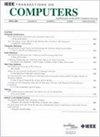通过封面揭开秘密:基于深度学习的反篡改封面Kyber实现侧信道攻击
IF 3.6
2区 计算机科学
Q2 COMPUTER SCIENCE, HARDWARE & ARCHITECTURE
引用次数: 0
摘要
在针对加密实现的典型EM侧信道攻击(SCA)中,探针可以直接接触微控制器。然而,在更实际的设置中,例如FIPS 140-3或ISO/IEC 19790标准的安全级别2,微控制器需要由不透明的防篡改盖保护。这提出了一个有趣的问题:即使配备了保护罩,我们仍然可以对运行加密实现的微控制器发动EM攻击吗?本文提出了一种改进的基于深度学习的针对NIST KEM标准Kyber的剖析攻击。我们的关键观察是,探头和微控制器之间的距离导致信号强度的衰减。此外,所述罩限制了探头的接近度,从而限制了信噪比。我们提出了一个自适应瘦金字塔网络(ASPN)模型来实例化基于明文检查的基于oracle的SCA中的标识符,该模型具有通用性和易于实现的特点。所提出的ASPN方法通过采用金字塔网络结构显著提高了特征提取过程,同时避免了过多参数的包含。现实世界的实验表明,我们提出的区分器在$18$ mm的覆盖下达到了高于$99\%的准确率,即使在$24$ mm的覆盖下也达到了高于$89\%的准确率。本文章由计算机程序翻译,如有差异,请以英文原文为准。
Uncover Secrets Through the Cover: A Deep Learning-Based Side-Channel Attack Against Kyber Implementations With Anti-Tampering Covers
The probe can directly contact the microcontroller in a typical EM side-channel attack (SCA) targeting cryptographic implementations. However, in a more practical setting such as security level 2 of FIPS 140-3 or ISO/IEC 19790 standards, the microcontroller is required to be safeguarded by an opaque anti-tampering cover. This raises an interesting problem: Can we still launch EM attacks against microcontrollers running cryptographic implementations even when equipped with the cover? This paper proposes an improved deep-learning-based profiled attack against NIST KEM standard Kyber. Our key observation is that the distance between the probe and the microcontroller results in attenuation of signal strength. Moreover, the cover restricts the proximity of the probe, thereby limiting the signal-to-noise ratio. We propose an Adaptive Slimmed Pyramid Network (ASPN) model to instantiate a distinguisher in a plaintext-checking oracle-based SCA, which is generic and easy to implement. The proposed ASPN approach significantly enhances the feature extraction process by employing a pyramid network structure, while simultaneously avoiding the inclusion of excessive parameters. Real-world experiments demonstrate that our proposed distinguishers achieve an accuracy above $99\%$ $18$ $89\%$ $24$
求助全文
通过发布文献求助,成功后即可免费获取论文全文。
去求助
来源期刊

IEEE Transactions on Computers
工程技术-工程:电子与电气
CiteScore
6.60
自引率
5.40%
发文量
199
审稿时长
6.0 months
期刊介绍:
The IEEE Transactions on Computers is a monthly publication with a wide distribution to researchers, developers, technical managers, and educators in the computer field. It publishes papers on research in areas of current interest to the readers. These areas include, but are not limited to, the following: a) computer organizations and architectures; b) operating systems, software systems, and communication protocols; c) real-time systems and embedded systems; d) digital devices, computer components, and interconnection networks; e) specification, design, prototyping, and testing methods and tools; f) performance, fault tolerance, reliability, security, and testability; g) case studies and experimental and theoretical evaluations; and h) new and important applications and trends.
 求助内容:
求助内容: 应助结果提醒方式:
应助结果提醒方式:


